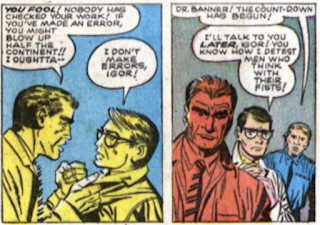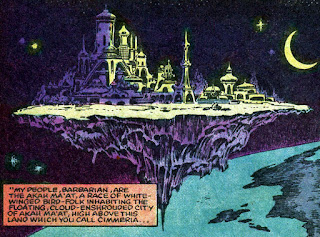The official narrative regarding the creation of the Hulk prompts one to question: Just what was going on at Los Diablos Missile Base? Let's review the eyebrow raising details: Bruce Banner is given a shocking amount of freedom to place restrictions on and make demands of the base’s military commander, a Russian scientist has somehow gotten security clearance, the control room is grossly under-staffed, and the detonation is down to just one push of a button. Ultimately this is all the result of the government's Cold War mentality, but the immediate cause of the irregularities in the base’s operation and the tragedy that followed is Dr. Bruce Banner.
The first mystery (this one obscured by governmental secrecy) is just what the gamma bomb was. It was not a gamma ray weapon—though that was exactly what Banner had dangled in front of the Army to get his project off the ground. Once he had funding and security clearance, Banner went for something more daring: he planned to build the K-Metal Bomb the German’s had sought near the close of World War II, but never perfected. He hoped to use the K-Metal (or Kryptonite as it was becoming popularly known) to power a weapon that would weaken and incapacitate but not kill (in a manner similar to so-called “slow kryptonite” developed years later by Metallo) and would also not destroy infrastructure. “Gamma” became the Army’s codename for this weapon.
Not only were the generals incredibly interested in what Banner was offering, but Banner’s secrecy (either conscious or unconscious) regarding the physics involved only served to leverage a virtual celebrity status for him. A status coupled with Cold War thinking regarding means and ends would prove disastrous for more than one person present that faithful day. Truth being more complicated than fiction, Windsor-Smith's version of these events in Monster would split Banner into two characters: a traumatized victim of a sadistic experiment and the sadistic scientist running the experiment.
The first mystery (this one obscured by governmental secrecy) is just what the gamma bomb was. It was not a gamma ray weapon—though that was exactly what Banner had dangled in front of the Army to get his project off the ground. Once he had funding and security clearance, Banner went for something more daring: he planned to build the K-Metal Bomb the German’s had sought near the close of World War II, but never perfected. He hoped to use the K-Metal (or Kryptonite as it was becoming popularly known) to power a weapon that would weaken and incapacitate but not kill (in a manner similar to so-called “slow kryptonite” developed years later by Metallo) and would also not destroy infrastructure. “Gamma” became the Army’s codename for this weapon.
Not only were the generals incredibly interested in what Banner was offering, but Banner’s secrecy (either conscious or unconscious) regarding the physics involved only served to leverage a virtual celebrity status for him. A status coupled with Cold War thinking regarding means and ends would prove disastrous for more than one person present that faithful day. Truth being more complicated than fiction, Windsor-Smith's version of these events in Monster would split Banner into two characters: a traumatized victim of a sadistic experiment and the sadistic scientist running the experiment.
Dr. Leonard Samson, psychiatrist, wrote extensively about the psychological dynamics of the principles after the fact. That Banner was rigid and emotional repressed was obvious to virtually everyone, but Samson argues that he projected his anger for his mentally ill and abusive father onto the bellicose General Ross and taunted him in a passive aggressive manner. (This, incidentally, only served to heighten Ross’ daughter’s attraction to the emotionally unavailable scientist.) It was Banner who demanded and got unprecedented control over the test and a limited, handpicked staff.
Which brings us to the oddest figure in this drama, “Igor Starsky,” the Soviet spy. Igor had been assigned to establish a relationship with Banner in graduate school—something not easy to do with the young physicist. For reasons of his own, Banner suffered Starsky’s presence, but seldom showed him any genuine warmth. When they were working together on the gamma bomb, he often treated the man like a lackey. Samson surmises that Starsky’s presence on the project was merely another way for Banner to assert his mastery over Ross, his father surrogate. He was the personification of foreign power in Ross’ domain. Banner would deny ever having considered that Starsky might be a Soviet agent, but he pointedly did not reveal any more of the science involved with the project to his colleague than to the military.
Why did Starsky attempt to kill Banner in the gamma bomb test when his presumed mission was not yet completed? Clearly, he had reason to resent Banner for the treatment he had received, but wouldn’t have stealing Banner’s secrets for his government been revenge enough? Samson believes Starsky’s murderous feelings against Banner were a reaction-formation of his attraction to the scientist. His tolerance of abuse had been the masochistic, unconscious expression of the depth of his feeling, but in a pivotal moment he pushed the button to free himself from Banner, and perhaps the intensity of his own feelings, once and for all.
That isn’t, of course, how it turned out.
Which brings us to the oddest figure in this drama, “Igor Starsky,” the Soviet spy. Igor had been assigned to establish a relationship with Banner in graduate school—something not easy to do with the young physicist. For reasons of his own, Banner suffered Starsky’s presence, but seldom showed him any genuine warmth. When they were working together on the gamma bomb, he often treated the man like a lackey. Samson surmises that Starsky’s presence on the project was merely another way for Banner to assert his mastery over Ross, his father surrogate. He was the personification of foreign power in Ross’ domain. Banner would deny ever having considered that Starsky might be a Soviet agent, but he pointedly did not reveal any more of the science involved with the project to his colleague than to the military.
Why did Starsky attempt to kill Banner in the gamma bomb test when his presumed mission was not yet completed? Clearly, he had reason to resent Banner for the treatment he had received, but wouldn’t have stealing Banner’s secrets for his government been revenge enough? Samson believes Starsky’s murderous feelings against Banner were a reaction-formation of his attraction to the scientist. His tolerance of abuse had been the masochistic, unconscious expression of the depth of his feeling, but in a pivotal moment he pushed the button to free himself from Banner, and perhaps the intensity of his own feelings, once and for all.
That isn’t, of course, how it turned out.
















.png/revision/latest?cb=20161201234356)















